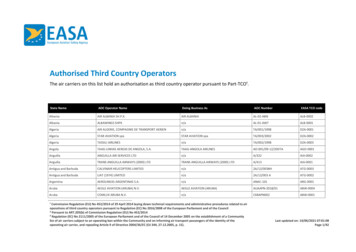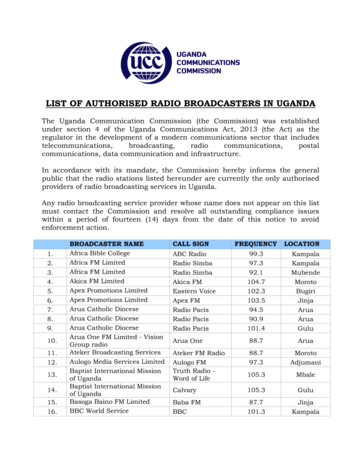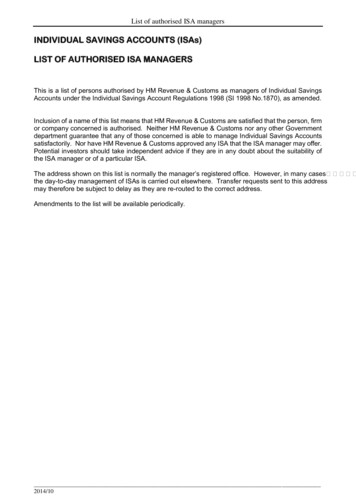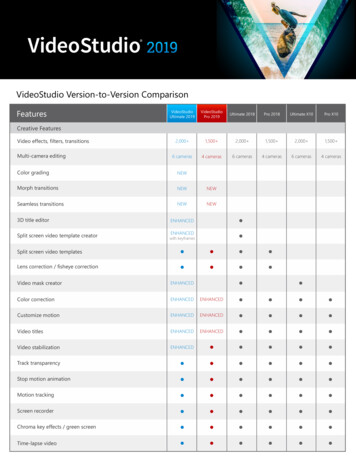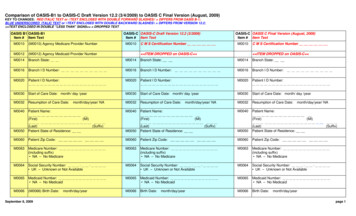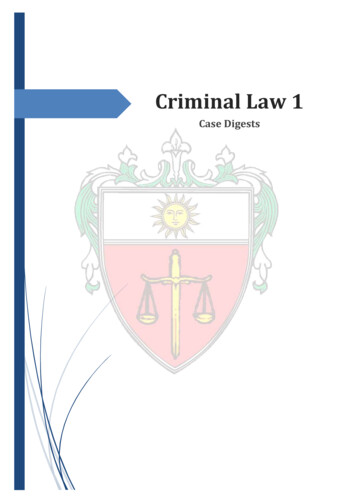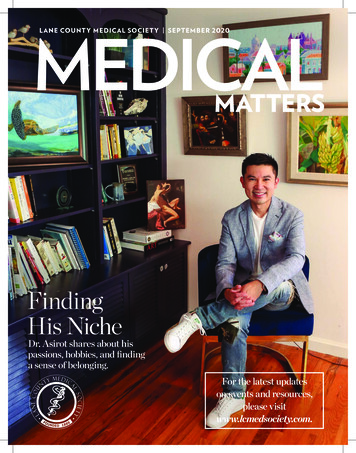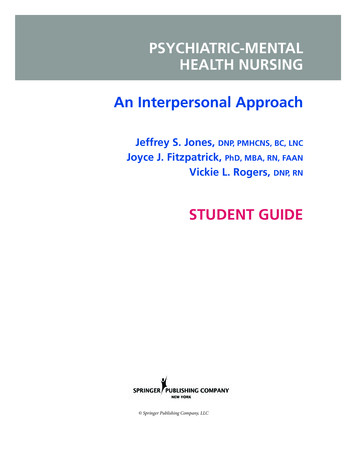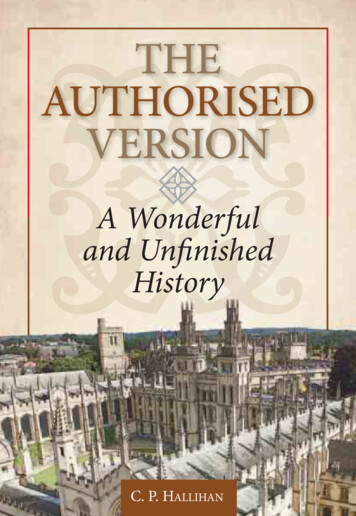
Transcription
THEAUTHORISEDVERSIONUA Wonderfuland UnfinishedHistoryC. P. HALLIHAN
THEAUTHORISEDVERSION:UA Wonderfuland UnfinishedHistoryC. P. HALLIHANTrinitarian Bible SocietyLondon, England
The Authorised Version: A Wonderful and Unfinished HistoryA124ISBN 978-1-86228-049-6 2010Trinitarian Bible SocietyTyndale House, Dorset Road,London, SW19 3NN, UK10M/ /1
CONTENTSPAGE 1TimelinePAGE 9Chapter 1:General IntroductionThe Manuscripts: Handwritten ScripturesPAGE 20Chapter 2:John Wycliffe and the English BiblePAGE 26Chapter 3:Technology, Scholarship and Martyrdom:The Printed English BiblePAGE 39Chapter 4:On to Hampton CourtPAGE 52Chapter 5:Printing: Techniques and ProblemsPAGE 58Chapter 6:The Last Chapter?APPENDICES:PAGE 68Appendix 1:1604 DIRECTIVESPAGE 70Appendix 2:THE ‘PRESENTATION’ OF THE BIBLEPAGE 73Appendix 3:WHY THE DIVERSION OF RESOURCES?PAGE 74Appendix 4:THE COMMITTEE MEN
ZTIMELINEc. 405Jerome’s Latin Vulgate translation of the Bible is produced and in widecirculation.500Portions of the Scriptures in five hundred languages available by this time.1066William the Conqueror invades England.1388Wycliffe’s first translation of the entire Bible into English, based on theLatin Vulgate, is published.1453Gutenberg invents the printing press. The first book printed is theBible in Latin—the Gutenberg Bible.1477-1487First printed Hebrew Scripture portions.1483The Golden Legend, Jacobus de Voragine’s ‘life of the saints’, compiledin the mid-13th century, is printed in English by ‘Wyllyam Caxton’. Itcontains a literal translation of a large portion of the Bible, all of thePentateuch, and much of the Gospels. At Genesis 3.7 ‘breeches’ is used,to reappear seventy-five years later in the Geneva ‘Breeches’ Bible.1509Accession of King Henry VIII.1516Desiderius Erasmus’ (1466–1536) first Greek New Testament isprinted and published by Froben in Basel; said to have had greaterinfluence on Tyndale than either the Vulgate or Luther.1517First Biblia Rabbinica Hebrew Old Testament, printed by DanielBomberg, includes the Targums and other traditional explanations.1
1518First separate printed Greek Bible (Septuagint and Koiné NewTestament), in Venice by Aldus.1522First German (Luther) New Testament, Wittenberg.1525William Tyndale’s New Testament, based on Erasmus’ Greek,completed. His wording and sentence structures are found in mostsubsequent English translations.Second Biblia Rabbinica, the first with the Hebrew Masoreticnotes, edited by Jacob ben Chayyim.1530Tyndale produces his first translation from Hebrew into English whenhe publishes the Pentateuch.1535Myles Coverdale, student of Tyndale, produces a Bible. It includes theApocrypha.1536Tyndale is executed. Tyndale did not live to complete his OldTestament translation, but left manuscripts containing the translationof the historical books from Joshua to 2 Chronicles.1537Matthew’s Bible printed—Tyndale’s translation supplemented byCoverdale’s.1538Coverdale’s Diglot (Latin/English) New Testament.1539The Great Bible, basically Matthew’s Bible, authorised for public use.1546Robert Stephens’ first Greek New Testament.Council of Trent declares Latin Vulgate to be the official version ofthe Bible in the Roman Catholic Church.1547Accession of King Edward VI.2
155 Robert Stephens’ third Greek New Testament, considered his mostimportant.1553Accession of Queen Mary I.1557Geneva New Testament is published by William Whittingham inGeneva, Switzerland. First in English to use verses, and italics forsupplied words.1558Accession of Queen Elizabeth I.1560The Geneva Bible is printed, compiled by exiles from England in Geneva:a meticulous rendering from Greek and Hebrew, set in roman type; onehundred and forty editions are published between 1560 and 1644.1565First Beza Greek New Testament.1568Bishops’ Bible, also called Parker Bible; twenty-two editions arepublished, the last in 1606; it is not popular, and not well edited.1584Plantin’s Biblia Hebraica.1587First Greek New Testament printed in England.1598Beza’s last major Greek New Testament. The Authorised Versionagrees substantially with this edition.1603Accession of King James I of England.1604Hampton Court Conference, during which the decision to translatethe Bible now known as the Authorised Version was made.3
1609–1610Rheims-Douai Bible is the first complete English Roman CatholicBible. It is called Rheims-Douai because the New Testament wascompleted in Rheims, France, in 1582 followed by the Old Testamentin Douai, 1609. The fourteen books of the Apocrypha are integratedinto the canon of Scripture in the order written rather than keptin a separate section.1611AUTHORISED VERSION:The sixty-six books of Scripture, with the additional fourteen books ofthe Apocrypha as a separate section (the Apocrypha was only officiallyremoved from the AV in 1885).1624Elzevirs’ first Greek New Testament.1629First Cambridge edition of the AV, revised to correct errors found inearlier editions, particularly in italics and punctuation.1631The ‘Wicked Bible’ printed in London by ‘Robert Barker and assigns ofJohn Bill’, 8vo;1 the word ‘not’ was omitted from the SeventhCommandment; the mistake was discovered before the printing wasfinished, and copies exist with and without the mistake.1633Elzevirs’ second Greek New Testament; contains the phrase ‘TextusReceptus’.1637The ‘Religious Bible’, so named because of the reading in Jeremiah 4.17‘Because she hath been religious [for ‘rebellious’] against me, saith theLORD’. Edinburgh, 8vo.1638Cambridge folio edition of the AV, by Thomas Buck and Roger Daniel,clear but smaller roman type, hand-ruled with red lines; text as revisedby Dr. Goad, Dr. Ward, Mr. Boise, and Mr. Mead, ‘ probably the bestedition of King James’ Version ever published’.24
1642Folio edition of AV published in Amsterdam, first of many editions(Canne’s Bibles) originating there, with notes and/or a prologuewritten by John Canne, prominent among the Brownists.31643Soldier’s (Cromwell) Pocket Bible (Geneva version).1655-1657Walton’s London Polyglot.1717J. Baskett Imperial Folio (‘Vinegar’) Bible, two volumes. The Luke 20chapter heading has ‘vinegar’ for ‘vineyard’—‘The Parable of theVinegar’. It was said to be the most sumptuous of all the Bibles printedat Oxford, and very beautiful. Careless proofreading led to the editionbeing called ‘a Baskett-ful of printers’ errors’.1762University of Cambridge edition of the AV, edited by Dr. Paris,published in folio and quarto editions; all but six copies of the folioedition were reportedly destroyed by fire.1763John Baskerville’s Cambridge Bible, a masterpiece of craftsmanship; 1,250copies were produced, with 500 of them ‘remaindered’ five years later.1769Oxford University edition of the Dr. Paris AV, edited by Dr. Blayney;commonly regarded as the standard edition, from which modernBibles are printed.1782Robert Aitken’s Bible, the first English language Bible printed inAmerica (AV without Apocrypha).1801The ‘Idle Shepherd Bible’, so called because of the reading in Zechariah11.17 ‘Woe to the idle [for ‘idol’] shepherd that leaveth the flock’.1805First printing of the New Testament at Cambridge by the newlyperfected stereotype process from stereotype plates.5
1806The ‘Discharge Bible’: ‘I discharge [for ‘charge’] thee before God’ in1 Timothy 5.21.The ‘Standing Fishes Bible’: ‘and it shall come to pass that thefishes [for ‘fishers’] shall stand upon it ’ in Ezekiel 47.10. Bible inquarto by the King’s Printer, London, reprinted in a quarto edition of1813, and an octavo edition of 1823.1807The ‘Ears To Ear Bible’: ‘Who hath ears to ear [for ‘hear’], let him hear’Matthew 13.43. Found in an octavo Bible published by the OxfordPress. The same book contains a more serious blunder in Hebrews9.14: ‘How much more shall the blood of Christ, who through theEternal Spirit offered himself without spot to God, purge yourconscience from good [for ‘dead’] works to serve the living God?’.1831Bagster’s London Polyglot.1833AV published at Oxford, an exact reprint, page for page, of the firstissue of 1611. Large quarto, with the spelling, punctuation, italics,capitals, and distribution into lines and pages followed with the mostscrupulous care; the type is roman not black letter.41841English Hexapla New Testament: textual comparison showingGreek and six English translations in parallel columns. ENDNOTES:1. The terms folio, quarto (4to) and octavo (8vo) refer tothe sizes of books, folio being the largest, followed by quartoand octavo.2. J. R. Dore, Old Bibles, 2nd ed. (London: Basil Pickering,1888), p. 345.3. Brownists were nonconformists in the 16th and 17thcenturies who separated from the Church of England andformed independent churches in England and Holland.4. See a discussion of black letter in Appendix 2.6
THEAUTHORISEDVERSION:UA Wonderful andUnfinished History7
Chapter 1GENERAL INTRODUCTIONThe mighty God, even the LORD, hath spoken,and called the earth from the rising of the sununto the going down thereof.Psalm 50.1t is the touchstone of Protestant preaching, teaching, life andpractice that God has spoken, and that the Bible is the inspiredand authoritative record of this. The Bible is ‘the holy scriptures, which are able to make thee wise unto salvation throughfaith which is in Christ Jesus. All scripture is given by inspiration of God, and is profitable for doctrine, for reproof, for correction, for instruction in righteousness’ (2 Timothy 3.15,16). In English we havethe inestimable blessing of the Scriptures in our own tongue; in our English Authorised Version, first published in 1611, we have rich, dependable, proven provision, in both text and translation, of the Word of God. It is the crown of onehundred years of labour, from the translating of Tyndale and Coverdale in theearly decades of the 16th century to the proofing and polishing by Miles Smith ofthe Hampton Court committees’ work, 1609–1610.The Reformation deliverance of the Gospel from the lifeless encrustations of medieval Romanism went hand-in-hand with the deliverance of the Scriptures frombeing a hidden book to being a book for both preacher and people. Recovery ofthe Gospel as the good news for sinners rather than an instrument of fear andoppression was inseparable from the recovery of the Bible for pulpit, pew, andpersonal religion. John Wycliffe had laid down markers two hundred years earlier with a clear view of the Scriptures as Christ’s Law and commitment to theirinherent authority rather than that of the church. He had a very rugged perception of the free Bible as mighty under the hand of God to the pulling down of thestrongholds of error and had a burden for their availability in the language of thepeople. These deep convictions were plainly maintained by God and pursuedfrom Tyndale, Coverdale, Cranmer, Reynolds, and onward.The Book which brings to us the wonderful works of God has good news to tell,and the history of this Book in our own language is a living part of any worthwhile ‘church history’. A sense of history is a great asset to the Christian life because our religion is necessarily historic, God at work in His creation, amongstHis creatures, rooted in time and place—real people and events in a way thatcannot be said of any other religion. Such a history also brings to view the issuesat stake in the proper transmission of the divine record: which texts, translatedunder which principles, and does it matter?9
THE AUTHORISED VERSION —The principles and procedures for establishing a reliable starting place—a‘ground text’—were not major issues in the beginning of English Bible translation. As is too often the case, it took controversy, opposition and hostility tobring about the realisation that in the English tongue from 1524 to 1604, inGreek textual scholarship from Erasmus 1516 to Beza 1598 and Hebrew manuscript availability from Bomberg in 1517 to Plantin 1584 and on, a settling of thetext of Scripture was being accomplished. If ‘the mighty God, even the LORD, hathspoken’, then it is needful to have the record of that speaking not only in our owntongue accurately and faithfully rendered, but also, to all human endeavour, settled in our own tongue.THE MANUSCRIPTS: HANDWRITTEN SCRIPTURESWith mine own handPaul’s letter to the Galatians is probably one of the earlier pieces of NewTestament writing. In chapter 6, verse 11 he declares ‘Ye see how large aletter I have written unto you with mine own hand’.1 This reminds us of abasic fact to do with the unfolding history of the New Testament, a point so obvious that we easily overlook it. Since printing did not come into being until themid-15th century, for the first three-quarters of the New Testament’s existence itwas only available in copies made by hand, truly ‘manu-scripts’, two Latin wordsmeaning handwritten.2Palestine in Apostolic times was under Roman rule, but for about three hundredyears before that it had been under the cultural dominion of Greece. Greek wasthe everyday language throughout the whole Mediterranean region, acceptableeven in Rome. This was the language of ‘the fulness of the time’, and was the instrument used, under the sovereign Spirit of God, for that written record whichis the New Testament of our Lord and Saviour Jesus Christ. Very quickly the burden of copying and translating these Scriptures was taken up by the churches.The practicalities of multiplying and disseminating accurately the written Wordof God start us on the path to the present printed editions of our English Authorised Version.Rolls and papyrusIn New Testament times the Greeks and Romans used papyrus rolls forwriting of all sorts. Papyrus is the fibrous pith of a water plant once plentiful in the Nile but scarcely found there now. Two layers of fibres laid atright angles to each other, soaked, squeezed and glued, formed sheets of a materialthat could receive marks. The side with horizontal fibres was intended for writing(the ‘recto’) but it was quite possible to use the reverse (the ‘verso’) as well.The best quality sheets were those usingthe largest fibres, and such sheets werejoined side-by-side to make rolls of neces10
— A Wonderful and Unfinished Historysary length for the particular document. The longest known roll is 133 feet(40.5m), but the average length of Greek literary rolls was 35 feet (10m). Heightwas variable, the usual being 10 inches (254mm) although 19 inches (483mm)was not unknown, and there were ‘pocket’ scrolls of only 5 inches (127mm). Onsuch papyrus rolls the writing was most often in columns 2.5 to 3 inches (64 to76mm) wide.There were margins between columns and at the top and bottom for annotationsand the insertion of corrections. Ordinarily, rolls were written only on one side,but if material was scarce or there was a lot to be said, they could be written‘within and without’ (Ezekiel 2.10) or ‘within and on the backside’ (Revelation5.1). Sometimes the verso of an existing work was used for more writing—oneearly 4th-century manuscript of Hebrews is on the back of a 3rd-century condensed Livy.3Taking average figures as a guide we can visualise the autographs of the New Testament (that is, the first written documents made by John, Luke, etc.) written inthis manner. An epistle such as 2 Thessalonians would be contained on a 5-footroll of five columns only. Romans would need 11.5 feet, Revelation 15 feet, Mark19 feet, and Luke 32 feet! So long as the papyrus roll was the medium of literature, the various copies of the books of the New Testament almost certainly circulated separately, and each book has its own ‘history’. Indeed, until the use ofthe printing press in the 15th century, few Christian communitiesand even fewer individuals possessed all the canonical books.Imagine the difficulties ofusing scrolls. I can mentionPapyrus reed beds along the Nile(below) and a detailed sample ofpapyrus paper showing the patternof fibres (right)11
THE AUTHORISED VERSION —Revelation 5.1 or Ezekiel 2.10 and expect you easily to find this reference in aBible. But what if you had a collection of scrolls to sort through to find the rightbook, and rather than pages to turn had to roll the scroll out to where you thinkthe particular passage might be! Remember, there are no ‘reader aids’ or w difficult to find the exact verse—perhaps we should excuse those earlyChristian writers who quote rather ‘freely’ or sometimes quote the same verseslightly differently, and often just say the quotation is found ‘somewhere in Luke’.Codices and vellumChristians were particularly concerned to improve on this situation. Asearly as the 2nd century AD ‘codex’ experiments were tried. A papyruscodex is made up of sheets of papyrus folded once into a ‘quire’ or gathering, like a gigantic scrapbook; this is in fact the basis of the book as we have ittoday. For this we have the church to thank: it was the desire of the churches for‘user friendly’ and portable Scriptures that helped establish this now universal system of book construction. Truly, in the providence of our mighty God, the fullrecord of His Word deserves, even in this small but significant point, to be called‘The Book’.Quires were fastened by threads through the inner margin, like a modern staplingprocess, and sometimes monstrous fifty-sheet folds were used in a single cumbersome quire. One famous papyrus codex referred to as P46 in the cataloguing system for these documents, and called Chester Beatty II, was once a single quirecodex of one hundred and four leaves—only eighty-six are known to exist now. Amore usual format was quires of eight to twelve leaves, joined as needed.The main advantage of this was that more material could be contained, and moreeasily consulted, without the volume becoming unmanageable. P46, referred toabove, originally contained all the Pauline epistles except Timothy and Titus. As ascroll this would have been some 60 feet in length—or at least two 30 footers. Thefive separate scrolls needed for early copies of the Gospels and Acts were replacedin the 3rd century by one codex, P45 (Chester Beatty I).Another step in the external form of New Testament material came with the ‘official’ establishment of Christianity under the reign of Emperor Constantine, in the4th century. The status of the Christian documents changed abruptly, and thewholesale destruction of books that had accompanied earlier persecutions ceased(for a while). Demand began to grow, instead, throughout the empire as Christianity became respectable.12
— A Wonderful and Unfinished HistoryJust at this point the book makers reintroduced vellum as the writing material. It hadbeen in use for some time, in Pergamumfrom about 190 BC (and it is a form of thename of that town which gives us the name‘parchment’ for vellum), but never on a largescale. Vellum is made from the skins of cattle,sheep and goats, especially young ones. The hairis scraped off, the skins washed, rubbed withpumice, and dressed with chalk, giving an almostwhite sheet, durable and easy to write on in blackor certain other colours. Once Christianity became an imperial religion, the physical appearance of the books took on an importance that hadnot been there before, and some of the vellumcodices of Scripture are extremely beautiful thingsto look at, though not necessarily reliable or accurate because of that!Just to complete the picture, note that ‘paper’, a Chinese cloth-based refinement of the papyrus writingmaterial, appeared in the West in the 12th century,but from the 4th to 15th centuries vellum was the preferred material.Part of P46 showing2 Corinthians 11.33-12.9Hebrew tooThe hand copying of the Hebrew Scriptures was always a more circumspectwork. There was never the urgent pressure to multiply and disseminate ascame with the New Testament. Every man was to make or have made acopy of the Torah (Law) for his personal use (Deuteronomy 31.195), a work thatwould be meticulous and unhurried. Scroll copies for Temple, king (Deuteronomy 17.18–19), and, later, synagogues and scribes, were made with reverential,word-and-consonant-counting care from a preserved exemplar6 (Deuteronomy31.26). It is a fascinating story in its own right, but for now I record only that theHebrew Scriptures, which we know as our Old Testament, continued to be copiedinto the Christian era.After the destruction of the Temple in AD 70 the Jews were exceedingly anxiousto maintain their correct text. From about AD 90 the addition of ‘points’ to showvowel sounds and various stress and cadence indicators was introduced into theconsonantal Hebrew to ensure the correct understanding of the text. Carefulcopying continued, and the Hebrew Scriptures were certainly known to theChristian world. Origen included a Hebrew text in his six-column Hexaplaaround AD 240, and Jerome used Hebrew directly (rather than the early Greek13
THE AUTHORISED VERSION —translation of the Old Testament, theSeptuagint) as a source for his Bethlehem Latin Bible of AD 405. After that itbecame more difficult to acquire eitherthe language or copies of the Hebrewtext in a Christian setting; even the attempt would attract suspicion and hostility from Jew and Christian alike. Butthe time would come.Destruction of the Temple, AD 70TranslationsScripture, existing in three languages and offering translations within itself(e.g., Matthew 1.23; Mark 5.41, 15.22,34; John 1.38,41,42, 9.7; Acts 4.36, 9.36,13.8), is inherently translatable, and response to the need for Scriptures inthe vernacular (or common language of a people) is as old as the New Testament.7Early translation of the New Testament from Greek into Latin began about AD180, not in Italy, but in North Africa. Such translation of the Old and New Testaments into Latin is referred to as the ‘Old Latin’; both Testaments were in facttranslated from Greek sources. Around 300 there was a translation of the NewTestament into Syriac, the ‘Old Syriac’, called also the Peshitta—that is, the ‘simple’version.8 There were also four versions in Coptic, the language spoken in four dialects in Egypt, and other early translations in Armenian, Georgian, Ethiopic,Slavonic and Gothic.The most significant and influential work began in 380, when Jerome wastranslating anew into Latin the Old Testament from Hebrew and the NewTestament from Greek. This return to Hebrew rather than the standard GreekSeptuagint as the proper source for Old Testament translation, although beyonddoubt the correct procedure, was strongly resisted and resented at the time. Therewere several Latin editions, and this version, styled the ‘Vulgate’ because it was thevulgar or commonly used language, became the Bible of Western Christianityuntil the Protestant Reformation inJerome at work on the Vulgatethe 1500s.9Apart from the long, slow adulterationof the Vulgate text over the next thousand years,10 the venerated Latin textgenerated problems for translation allthrough that time. From Augustine toErasmus, Bible translation never escaped the incubus of Latin as thesource text. Thus, increasingly slanted14
— A Wonderful and Unfinished Historyinterpretations in the Vulgate made their way into the few non-Latin translationsthat were produced.This historical period of scholarship, in very general terms, is that of the ByzantineEmpire, centred in Byzantium, formerly Constantinople. Most Greek scholarshipwas focused there; and literature, including many Biblical texts, were never carriedbeyond the area, and thus, for a time, were beyond easy reach of the Westernworld.Early English endeavoursFirst the apologies. Without intent to offend, the word ‘English’ is being usedas a catch-all for indigenous languages spoken in Britain and ‘adjacent islands’ in these early times. Please forgive the chronologically inexact use of‘English’ to include many lands, languages, scripts and dialects such as Celtic,Cymric, shades of Saxon, Irish, Welsh: it is done to save continual distinctionshaving to be drawn, rather than through ignorance or indifference.There were, then, yearnings and strivings toward the provision of English language Scriptures quite early in the Gospel history of the land. Chrysostom (347–407) hints of English Scriptures in Britain almost as soon as the Gospel arrived,and Gildas (504–570) certainly speaks in his Ruin of Britain of Scriptures and pastors being butchered together in British towns during the Diocletian persecution(284–305).11The goal of vernacular Scriptures was pursued throughout the so-called DarkAges, the ubiquitous but unhelpful title used vaguely to cover the thousand yearsfrom the decline of Rome in the 5th century to the fall of Constantinople in 1453.Certainly there are distressingly dark aspects of the history of that time, but themaintenance of Greek learning in Byzantium, the eager incorporation of Indianlearning into Muslim scholarship, and, perhaps more significant for our immediate purposes, the rugged sanctity, scholarship, mission and manuscript work ofCeltic Ireland must not be ignored or minimised.Roman legions left Britain in 409–410, to guard Italy after Alaric Iof the Visigoths (370–410) captured and sacked Rome. TheRoman garrison forces in Britain had long fluctuated betweenthirty and fifty thousand men, drawn from all over the Empire,with the attendant family, administrative and trading communities—and the ongoing settlement of time-expired legionaries.There is plain evidence that amongst these numbers there wereChristians. Alban12 was of the noble army of martyrs.It is also interesting that Constantine, who was Emperor from 306to 337 and legitimised Christianity throughout the Roman Empire,was first declared Emperor by legionary forces at York. British‘bishops’ had been present at the Council of Arles, in 314.13 OneConstantine AD 272-33715
THE AUTHORISED VERSION —hundred years later Augustine wrote his City of God in the aftermath of the destruction of Rome, and our nation provided a theological antagonist for him:Pelagius14 was from Britain; he taught in Rome and died in 418, Augustine in430.Archaeology in southern Britain has revealed traces of buildings dedicated toChristian use, but equally, if not more significantly, rooms set aside in homes forChristian meeting: small chapels and house meetings are no new thing. Thesebrethren would mostly be content with the Latin Scriptures, maybe even theJerome Vulgate, hot from Bethlehem.Amongst those left in Britain after 410 there were many Celts, and a ‘RomanoBritish’ residual culture lingered on to face the increasing incursions of Jutes,Angles and Saxons. Within that culture Christianity continued, refreshed andrenewed from time to time by Irish missions. This Irish connection is the genesisof some of the earliest English fragments of Scripture, from interlinear15 editionsto magnificent illuminated16 manuscripts.There was, then, a growing incentive for, at least, paraphrasing Scripture into theEnglish languages of that time. In the struggle to produce the Scriptures, the Psalmsand the Gospels have long beenfavoured as the first necessities fortruth and devotion, and so it washere. In the 7th century the monkCaedmon made a metrical version ofsome portions of Scripture, andTheodore of Tarsus (d. 690), seventhArchbishop of Canterbury, urgedupon all parents the need to teachtheir children the Lord’s Prayer in thecommon tongue. Bede translated theGospels into English, supposedly finishing the Gospel according to Johnon his deathbed in 735. The chronicler William of Malmesbury, 1090–1143, assures us that King Alfred,849–899, had memorised the NewTestament, Psalms and other OldTestament portions. Having rendered the Ten Commandments intoEnglish, Alfred was engaged at thetime of his death in a new translationof the Psalms.Title page for the Gospel according toMatthew, Lindisfarne Gospels16
— A Wonderful and Unfinished HistorySome interlinear translations have survived fromthe 10th century, the Lindisfarne Gospels produced by Aldred (c. 950) being the most famous.Aelfric (c. 955–1020) made rough and idiomatictranslations of Scripture portions, two of whichhave survived until today. Almost three hundredyears later, William of Shoreham and RichardRolle each translated the Psalter. Rolle’s work included a verse-by-verse commentary, and boththese Psalters were still popular at the time ofJohn Wycliffe.Copying the ScripturesIt must be acknowledged that the language used was quite variable throughout the‘kingdoms’ in Britain. An ‘English’ document produced in Wessex would not necessarily be useful in Mercia or Strathclyde or Northumbria. We would not findany of these older forms easy to the eye, ear or tongue now!Compare these renderings of Luke 2.7,11:11th century: Wessexand heo cende hyre frumcennedan sunu. and hine mid cildclaþumbewand. and hine on binne alede. forþam þe hig næfdon rum oncumena huse forþam todæg eow ys hælend acenned. se is drihtencrist on dauides ceastre14th century: Wycliffe& she childide hir first goten sone, & wlappede hym in cloþis &putte hym in a cracche, for þer was not place to hym in þe comunstable for a saueour is born to day to vs, þat is crist a lord in þe citeof dauidand for contrast:16th century: TyndaleAnd she brought forth her fyrst begotten sonne and wrapped himin swadlynge cloothes and layed him in a manger because ther wasno roume for them within in the ynne for vnto you is borne thisdaye in the cite of David a saveoure which is Christ ye lorde.Tyndale may look quaint, but is quite comprehensible—one can read it aloud andhearers would understand. But without some familiarity with the sounds and orthography of Anglo-Saxon English, it is none too easy to read Wessex or Wycliffe.17
THE AUTHORISED VERSION —An Anglo-Saxon manuscript of 995 rendersJohn 3.16 thus:God lufode middan-eard swa, dat he seade his an-cennedansunu, dat na
The Geneva Bible is printed, compiled by exiles from England in Geneva: a meticulous rendering from Greek and Hebrew, set in roman type; one hundred and forty editions are published between 1560 and 1644. 1565 First Beza Greek New Testament. 1568 Bishops’ Bible, also call

